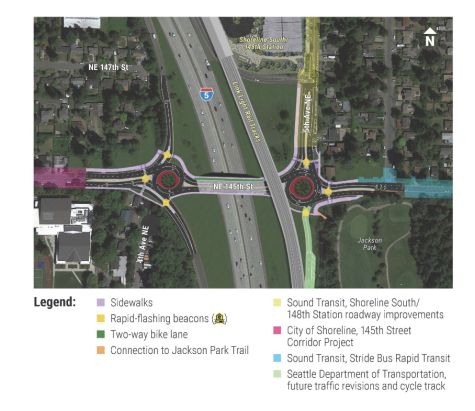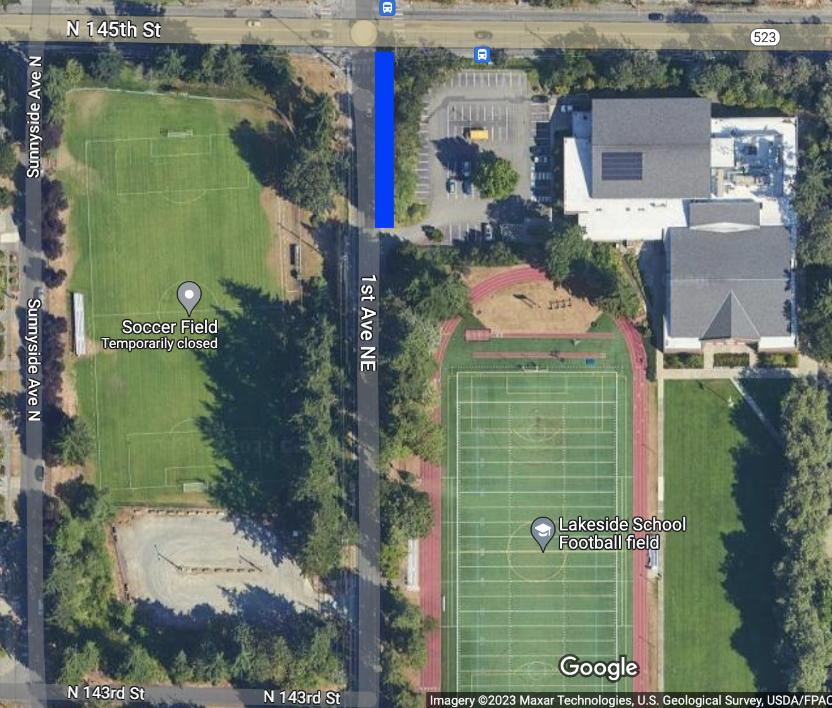Lakeside Negotiates with Shoreline on I-5
For many students “working” among a circle of friends on the Quad or trekking from the AAC to a southward red-brick building, Lakeside’s beautiful campus is a point of pride. However, with a bold new project on the City of Shoreline’s horizon, portions of the school’s pristine expanse seem to have come into question as the city pushes for control of land that hosts and houses students and faculty alike.
In November 2020, Shoreline announced its I-5 Interchange Project. Forecast to be complete by 2024, the project is an ambitious remodel of NE 145th Street from I-5 to Aurora Ave N that would ease traffic in the area. Due to the scope of the remodel, Shoreline’s leaders are working with numerous agencies such as the Washington State Department of Transportation, the City of Seattle, King County, and Sound Transit to realize the project.
The redesign project also comprises two subprojects and construction sites around Lakeside that will take place over the coming years. The first would designate a right turn lane from the intersection with NE 143rd and First Ave NE to service 145th Street. The new lane is meant to reduce after-school backup on First Ave NE as many head onto I-5 to make their way home.
This agreement was the result of a protracted period of negotiations between Lakeside and the City of Shoreline over the price and quantity of the land set to be taken. As CFO Birage Tandon explained, the negotiations were “never meant to fight the city’s plans. We don’t want that.” This is largely because if a stalemate in negotiations occurs, Shoreline can exercise its right to eminent domain and claim the land for a price they set. “That’s the last step or stage that no one hopes to reach,” Ms. Tandon stressed. “Because then we can’t say no.”
Therefore, negotiations first began over a year ago with an initial offer of approximately $158,000 from the city for the land. Lakeside countered the offer, beginning, beginning over a year and a half of conversations between the city, Lakeside, Lakeside’s attorney, and a hired arborist (“because part of the project involves the trees, there was a waterline to talk about, and more,” Ms. Tandon explained).
Ultimately, Shoreline reduced the scope of its land claims after negotiating with the school and because of environmental concerns over the effect the project will have on tree roots. Notably, the right turn lane will only start north of the AAC’s driveway, preserving the parallel parking by Parsons Field but not north of the AAC’s entrance. As Ms. Tandon reports, the deal was finalized soon after these concessions, with the land sold for $152,000.
Ms. Tandon anticipates that construction will begin in the next six months. In fact, some preliminary work has already begun, as the city shut off water to campus last October to move a water mainline that was blocking where they planned to dig. A team of arborists also recently reviewed the area that will become the right turn lane, tagging trees to be removed and deciding what trees will be planted in their stead. After Lakeside and Shoreline came to an agreement on the turn lane project, they shifted focus to the city’s second planned subproject.

The larger and more complex of the two, the second project would place a roundabout at the intersection of Fourth Ave NE and NE 145th Street to simplify exiting and entering I-5 and would also construct a seven- or eight-foot wall on either side of 145th Street at the roundabout. Ms. Tandon emphasizes that many Lakesiders shouldn’t feel any major repercussions from this initiative. The only loss is that cars and pedestrians will no longer be able to access 145th St from Fourth Ave behind the WCC. However, for CJ Jatabarry, a longtime member of the maintenance team, losses from the project include the demolition of his home.for CJ Jatabarry, a longtime member of the maintenance team, losses from the project include the demolition of his home.
On campus, Mr. Jatabarry is known for his unwavering spirit and approachability. Less well-known about him, however, is that he and his family of six live on Lakeside’s campus, in a white home owned by Lakeside directly off of Fourth Avenue. As Shoreline’s proposal stands, his home and land will be cleared to make way for the roundabout, its retaining wall, and a sidewalk. It’s a home he’s lived in for almost as long as he’s had a job here at Lakeside.
Mr. Jatabarry describes the anxiety he initially experienced at the possibility of losing his home: “At first I was like, ‘What?!’ because I really didn’t know what the project was and that the city could do that. And I was very nervous, because I have a big family.” Beyond the challenges of having to move with his family, Mr. Jatabarry also mentions concerns that his rent may rise after the move: “A larger rent is a little scary, especially with the way things are today.”
The timeline for negotiations alleviates some of Mr. Jatabarry’s anxiety about organizing a move, though. Ms. Tandon predicts the second project’s negotiations will be longer than the first due to its scale. Unlike the first project, an outright purchase of some of Lakeside’s land, the second project will be an easement: the land would stay in Lakeside’s hands, but Shoreline would be allowed to construct and maintain structures under certain conditions. Thus far, the city is yet to even make an initial offer to the school nor determine whether they want a permanent or temporary easement of the land. However the land transfer happens, though, Ms. Tandon estimates another year-long negotiation process at the very least but is confident it will happen and with satisfactory terms for Lakeside.
Mr. Jatabarry is similarly optimistic about the future. The school has already found him a new home nearby, for which he is deeply grateful. “I’m just happy to have so much support in my life from the school and especially from Mr. Dawkins,” CJ said. “There’s a bad side…that I have to move, but I know I’m going to help people and Lakeside by moving. That makes me want to do it, to do the right thing for everyone.” Then, with a chuckle, he quickly adds, “I know this is Seattle, but I just hope moving day is dry!”
Conceitedly, his favorite month is December
As his birthday falls in December 2006
And even more, his favorite holiday is that of December 25
As...

